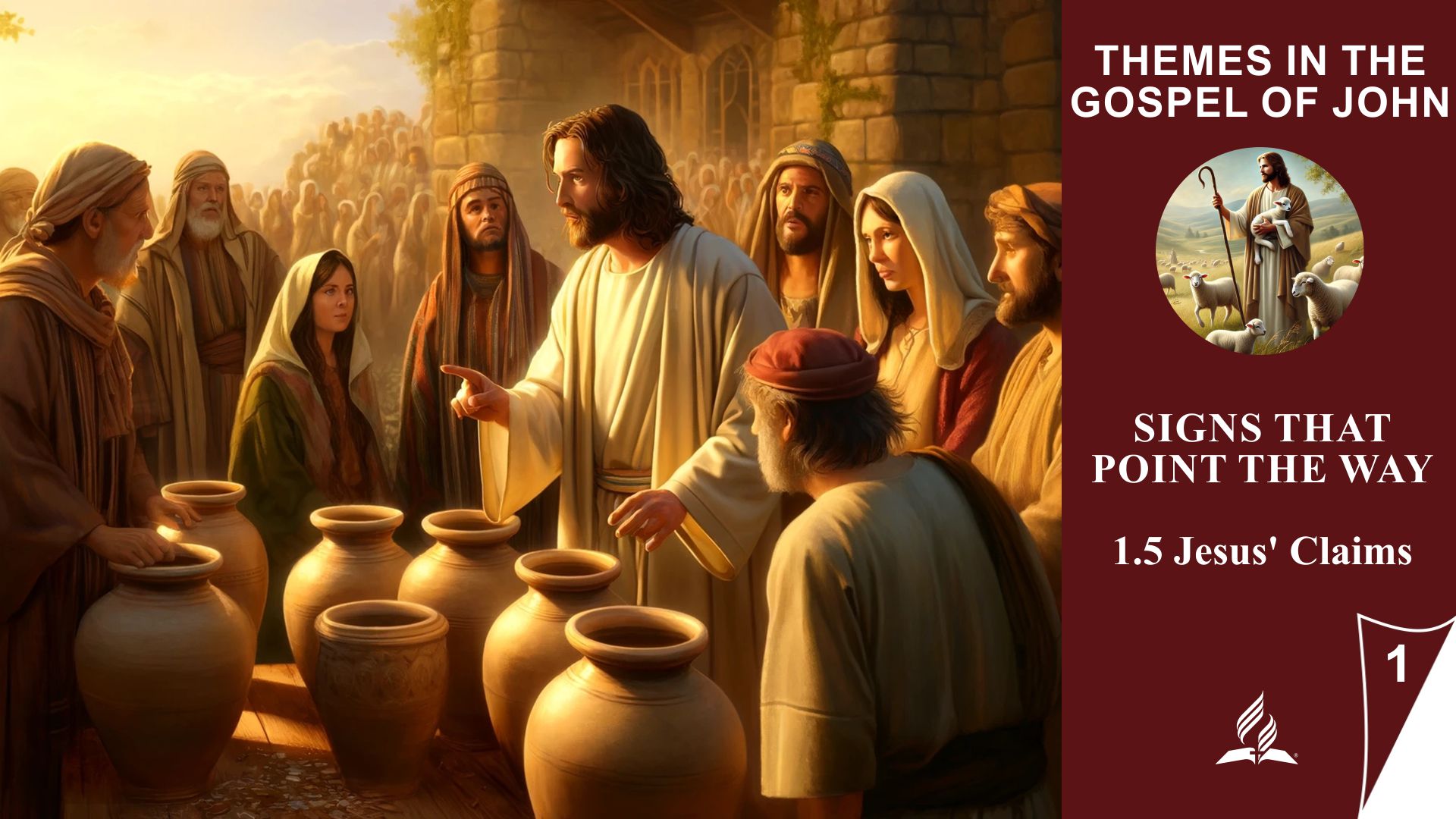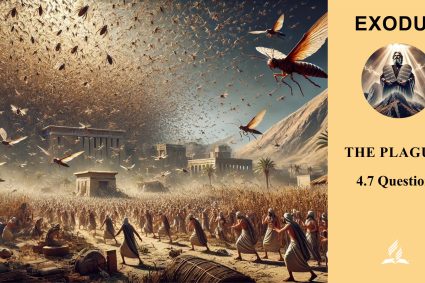


1.5 Jesus’ Claims
The Claim to Divinity
Read John 5:16–18. Why was Jesus persecuted for His actions on the Sabbath?
The miracle at the Pool of Bethesda provides John with an excellent opportunity not only to describe Jesus’ actions but also to reveal His identity as the Son of God. In John 5:16–18, it becomes clear why the religious leaders persecuted Jesus for His actions on the Sabbath. To them, His healing on the Sabbath constituted a violation of the Sabbath laws. However, the leaders’ anger went far beyond the mere “Sabbath-breaking”—it was Jesus’ claim to divinity that particularly infuriated them.
Why Was Jesus Persecuted for His Actions on the Sabbath?
Jesus explained that His work on the Sabbath was in line with the work of His Father. In John 5:17, He says, “My Father is always at his work to this very day, and I too am working.” Thus, Jesus made it clear that God’s work does not cease on the Sabbath. God sustains the universe even on the Sabbath, and likewise, Jesus brings healing and life regardless of the day. This was a significant affront to the religious leaders because Jesus was not only disregarding human Sabbath regulations but also presenting Himself as equal to God.
A Deeper Look at John 5:18
At first glance, John 5:18 might give the impression that Jesus “broke” the Sabbath. However, what Jesus did was in harmony with God’s nature and actions. His healing and His words make it clear that the Sabbath is a day of redemption, peace, and restoration—a day when God’s grace is visible. By healing on the Sabbath, Jesus did not question the law but revealed the deeper meaning of the Sabbath: God brings healing and life, not just rest. In this sense, Jesus claimed a special divine authority that goes beyond human traditions and regulations.
Jesus’ Claim to Divinity
The religious leaders saw Jesus’ actions on the Sabbath as a challenge to their authority and interpretation of the law. However, what troubled them even more was His claim to be equal with God. To them, this was blasphemy. But for John and the believers who read his Gospel, this reveals Jesus’ true identity: He is the Son of God, one with the Father. Jesus’ healing on the Sabbath was not only a miracle but a clear sign of His divinity and unique relationship with the Father.
Conclusion: John uses the miracle at the Pool of Bethesda to clearly demonstrate who Jesus truly is: the Son of God, Lord over the Sabbath, and life itself. The religious leaders persecuted Jesus because He violated their rigid rules and revealed Himself as God. Yet, it is precisely in this conflict that Jesus’ true nature becomes visible—He is the one who fulfills the Scriptures and reveals the true essence of God.
Read John 5:19–47. What does Jesus say to help the leaders recognize Him as who He truly is—a claim that was powerfully confirmed by the miracle He had just performed?
In John 5:19–47, Jesus defends His actions and powerfully reveals to the religious leaders who He truly is. He does this in three steps to help them recognize Him as the Messiah sent by God—a claim that was confirmed by the miracle of healing at the Pool of Bethesda.
-
Jesus’ Relationship with the Father (John 5:19–30): Jesus begins by explaining His unique and intimate relationship with God, the Father. He clarifies that He does nothing on His own initiative but only what the Father shows Him. Jesus and the Father act in perfect harmony. This close connection grants Jesus the authority to judge and even to raise the dead (v. 25–30). He emphasizes that life and authority over judgment come solely from the Father and are given to Him as the Son. With this explanation, Jesus underscores that His actions—even healing on the Sabbath—are entirely in line with God’s will.
-
The Four Witnesses (John 5:31–38): Jesus calls upon four witnesses to confirm His divine authority:
-
John the Baptist: John testified about Jesus by calling Him the “Lamb of God” and urging people to repent (v. 31–35).
-
The Miracles: Jesus points out that the works He does—including the healing of the paralyzed man—bear witness about Him and confirm His divine mission (v. 36).
-
God the Father: Jesus emphasizes that the Father Himself has testified about Him. This occurred both at Jesus’ baptism and through God’s ongoing guidance and work in Jesus’ ministry (v. 37–38).
-
The Holy Scriptures: Jesus reminds the leaders that the Scriptures they study also testify about Him. The entire Scripture points to Him, yet they fail to recognize Him (v. 39).
-
-
Accusation Against the Religious Leaders (John 5:40–47): In the final step, Jesus confronts the leaders with their own blindness and selfishness. Despite all these witnesses, they refuse to believe and receive eternal life through Jesus. Their hard-heartedness and pursuit of honor from people rather than from God make them incapable of recognizing the truth. Finally, Jesus brings up Moses, whom they honor and hope in. However, Moses will condemn them because they have not understood his writings (v. 45–47).
Conclusion: In this section, Jesus shows the religious leaders that there is ample evidence to recognize Him as the Savior sent by God—His relationship with the Father, the miracles, the testimonies of others, and the Scriptures. However, their own blindness and self-righteousness prevent them from seeing the truth. These words of Jesus also challenge us to examine whether we are truly open to God’s workings or if we are hindered by false notions and selfishness.
How Can We Guard Against Believing in God and Upholding Correct Teachings Without Fully Submitting to Christ? Prepare Your Discussion Contribution for Sabbath.
To ensure that our faith in God is not merely an intellectual confession or adherence to teachings but leads to complete submission to Christ, we can consider several essential points:
-
Personal Relationship Over Mere Theory: It is possible to know and uphold the correct teachings without maintaining a deep personal relationship with Jesus. A relationship with Christ requires more than just knowledge of the Bible. We must spend daily time in prayer and reflection on His Word to truly encounter Him. This personal relationship will transform our hearts and guide our lives far beyond mere adherence to teachings.
-
Humility and Self-Examination: Jesus confronted the religious leaders because they were proud of their knowledge and positions but unwilling to submit to the truth. We must regularly examine ourselves and ask: Am I willing to let Christ guide me in every aspect of life, even when it contradicts my own ideas or conveniences? True submission to Christ requires humility—the willingness to be corrected and led.
-
Love and Service as Signs of True Submission: The Bible teaches that faith without works is dead (James 2:26). Our lives should reflect the love and mercy of Christ. If we do not translate our love for God into practical service to others, we risk living our faith only theoretically. To be subject to Christ means to serve others in love and share His compassion.
-
Spiritual Fruits as a Measure: Jesus says that people will be known by their fruits (Matthew 7:16). If we truly submit to Christ, this should be visible through the fruit of the Spirit in our lives: love, joy, peace, patience, kindness, goodness, faithfulness, gentleness, and self-control (Galatians 5:22–23). We must ask ourselves: Are these fruits growing in me, or am I only focused on outwardly following rules?
-
Openness to God’s Will in All Areas: It is easy to trust God in certain areas of our lives but want to control other areas. True submission to Christ means trusting Him in every area—whether in our relationships, work, decisions, or even our worries. We must learn to relinquish control to God and place His will above our own.
-
Trusting in God’s Grace, Not Our Own Performance: There is a danger that we rely on our religious performance or knowledge instead of fully trusting in God’s grace. We must recognize that our salvation comes solely through Christ and not through our works or knowledge. This trust in His grace leads us to genuine submission and humility before God.
Discussion Contribution for Sabbath:
We can easily fall into the trap of upholding the correct teachings without fully submitting to Christ. The path to true submission begins with the willingness to lay our hearts and lives in His hands. This includes daily nurturing of our relationship with Him through prayer, self-examination, humble openness, and service to others. Ultimately, following Christ means trusting Him in all areas and aligning our entire lives with His guidance. This way, we avoid the danger of merely “formal” belief and experience the deep, transforming power of His work within us.
The Connection Between Jesus’ Claims and Our Daily Life and Faith Is of Central Importance.
In John 5:16–18 and the following verses, it is evident that Jesus is not merely a teacher or prophet but the Son of God who has a unique relationship with God the Father. This understanding challenges us in our daily lives to not only intellectually align ourselves with Him but to fully lay our lives in His hands.
Connection to Our Daily Life and Faith:
-
Placing Christ Above Traditions: Just as the religious leaders of Jesus’ time clung to their traditions and regulations, we too today can be prone to prioritizing our own religious or cultural notions over the living work of God. Jesus’ healing on the Sabbath teaches us that God’s actions and love go beyond human traditions. We should be open in our daily lives to how God works in us, even if it is different from our expectations.
-
Allowing God to Work in All Areas: Jesus explained that He does what the Father shows Him. Similarly, we are invited to live in close connection with God and allow Him to work in all areas of our lives. This means not only seeking God’s will in religious matters but also in our daily lives—relationships, work, decisions. Jesus as the Son of God teaches us that our faith must be holistic and encompass all areas of life.
-
Trusting in God’s Grace: The religious leaders persecuted Jesus because He broke the Sabbath and equated Himself with God. They could not recognize that His actions were expressions of God’s grace and mercy. In our faith life, it is about not relying on our own achievements or merits but on God’s grace revealed in Christ. This grace should shape our daily lives and make us people who pass on God’s love.
-
Openness to Jesus’ Divinity and Guidance: Jesus’ claim to divinity poses the question of whether we truly submit our lives to Him. Often, we may intellectually acknowledge God and uphold the “correct teachings” but not fully surrender to His guidance. In our daily lives, we should continually ask ourselves if we are willing to accept God’s will in every aspect of our lives, even if it upends our own plans or ideas.
-
The Sabbath as a Day of Restoration: Jesus demonstrated through His actions that the Sabbath is not only a day of rest but also a day of healing and restoration. This deeper meaning of the Sabbath can also shape our faith and daily life. The Sabbath is an opportunity not only to find physical rest but also to experience inner healing and renewal in God’s presence. We can apply this principle of healing and restoration in our daily lives by regularly giving ourselves and others space for renewal and peace.
Conclusion: Jesus’ claims to divinity and His revelation as the Son of God who acts in harmony with the Father invite us to live our faith fully in our daily lives. This means not only following religious rules but cultivating a living, transformative relationship with Christ. It calls us to be open to His workings and recognize Him as the one who embodies the deepest truth and life itself. In our daily lives, this is manifested through trust, submission, and the willingness to accept God’s grace in every aspect of our lives.
Trust that God’s workings go beyond human notions and bring healing and renewal into your life.
(Visited 17 times, 1 visits today)






















